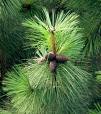Pinus Washoensis Tree Information
Images of Pinus Washoensis:






Pinus Washoensis grows in the following 4 states and provinces:
British Columbia, California, Nevada, OregonInformation about Pinus Washoensis:
The Pinus Washoensis is commonly known as the Washoe Pine as well as Yellow Pine.
The currently accepted scientific name of Washoe pine is Pinus washoensis Mason and Stockw. . There are no recognized subspecies, varieties, or forms. Washoe pine origins are uncertain. Haller proposed that Washoe pine resulted from hybridization between either Pacific ponderosa pine (P. ponderosa var. ponderosa) and Jeffrey pine (P. jeffreyi) or Pacific ponderosa pine and Rocky Mountain ponderosa pine (P. ponderosa var. scopulorum). Mirov dismissed Jeffrey pine as a possible ancestor on chemical and morphological grounds, suggesting that Washoe pine is a variety or mutant of ponderosa pine. Critchfield stated that Washoe pine is a Pleistocene derivative of Rocky Mountain ponderosa pine. Washoe pine sets more sound seed per cone in artificial crosses with Rocky Mountain ponderosa pine than in natural intraspecific crosses. This rare instance of heterosis for seed set in interspecific conifer hybrids establishes a strong and direct evolutionary relationship between Washoe pine and the Rocky Mountain ponderosa pine . Washoe pine hybridizes with Pacific ponderosa pine and rarely with Jeffrey pine .Washoe pine occurs in three mountain ranges on the western rim of the Great Basin in northeastern California and northwestern Nevada . It occupies a few square miles on the east slopes of Mount Rose, Nevada, and can be found in small stands in the southern Warner Mountains and in the Bald Mountain range of northeastern California . Isolated stands have been reported in Oregon and British Columbia . Washoe pine typically occurs in pure stands at higher elevations along the eastern slope of the Sierra Nevada. In the northern Sierra Nevada and into the southern Cascade Range, it forms mixed stands with Jeffrey pine, Pacific ponderosa pine, incense cedar (Libocedrus decurrens), white fir (Abies concolor), California red fir (A. magnifica), and western juniper (Juniperus occidentalis) . Other common tree associates include sugar pine (Pinus lambertiana) and quaking aspen (Populus tremuloides var. aurea). Other associates include mountain sweetroot (Osmorhiza chilensis), white hawkweed (Hieracium albiflorum), greenleaf manzanita (Arctostaphylos patula), mountain big sagebrush (Artemesia tridentata ssp. vaseyana), antelope bitterbrush (Purshia tridentata), snowbrush ceanothus (Ceanothus velutinus), wooly wyethia (Wyethia mollis), snowberry (Symphoricarpos vaccinioides), Idaho fescue (Festuca idahoensis), Wheeler bluegrass (Poa nervosa), and Orcutt brome (Bromus orcuttianus) . Publications listing Washoe pine as a dominant species are: Preliminary descriptions of the terrestrial natural communities of California Symposium Proceedings--plant communities of southern California Forest habitat types of the South Warner Mountains, Modoc County, California Montane and subalpine vegetation of the Sierra Nevada and Cascade Ranges . Some of the information provided here is attributed to:Esser, Lora L. 1993. Pinus washoensis. In: Fire Effects Information System, [Online]. U.S. Department of Agriculture, Forest Service, Rocky Mountain Research Station, Fire Sciences Laboratory (Producer). , available at the USDA Fire Effects Information System (FEIS) website